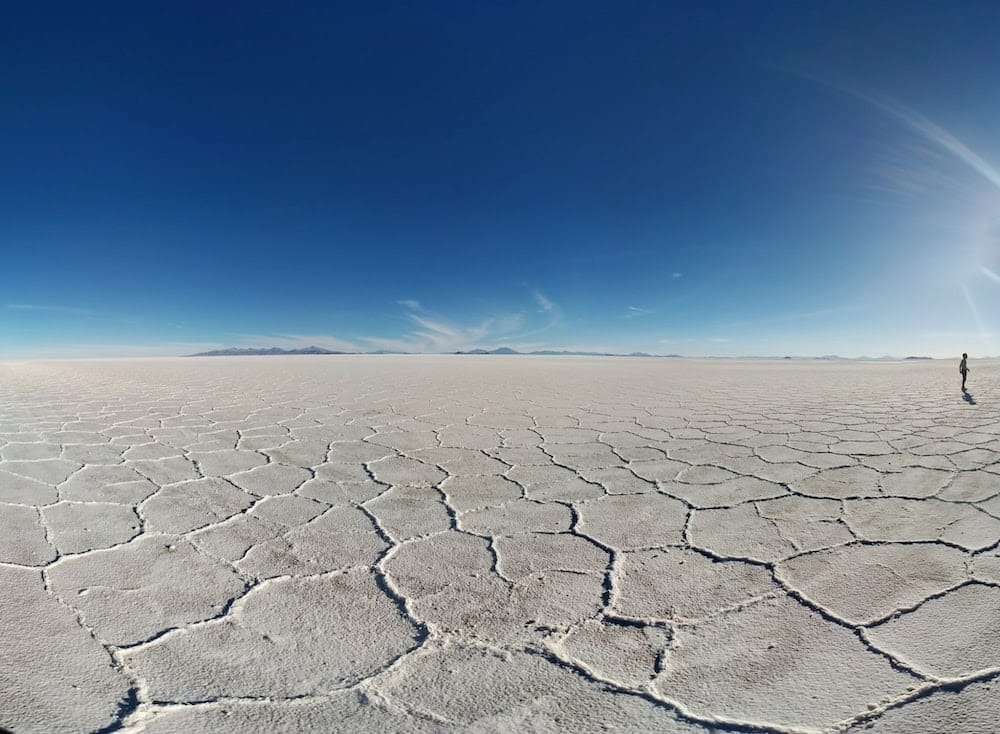
The laws of conservation of mass and energy apply to planet Earth as they do to any physical system. For the Earth, almost all energy exchanges with its cosmic environment are radiative: radiation received from the Sun (in the visible, near-infrared and ultraviolet wavelength ranges) and thermal radiation emitted by the Earth (in the mid-infrared). The Earth’s radiation balance can be understood as a global energy balance, close to zero since the planet is not very far from equilibrium. The balance of energy gains and losses is written:
Net global balance = absorbed solar radiation + internal heat production – thermal infrared radiation emitted towards space.
It should also be noted that heat production by natural radioactivity inside the Earth is very low (around 0.1 watts per square metre) compared with the radiative fluxes absorbed or emitted by the planet (239 W – m-2).
As for the production of non-renewable energy by human activities, this is negligible, even if it does produce heat islands in major cities.

Elements of the Earth’s overall radiation balance
It is, however, more informative to examine the elements of this overall balance, i.e. to study in detail the balance of radiation exchanges of various types between the planet, the Sun and space as a function of place and time. After all, you can take stock of your financial assets from one year to the next to see whether you have more or less savings or debts, but it’s still important to know where your money comes from and what you’ve spent it on.
Please note that the following explanations relate to the elements of the radiation balance at the “top” of the atmosphere, which by convention can be situated at 30 km, since very little infrared or solar radiation is emitted or reflected above this altitude. The atmosphere extends well above 30 km, with no clear limit, but for the lifetime of satellites, we place this limit approximately between 500 and 800 km.

Solar radiation balance
Solar radiation is close to 1,365 W – m-2 on a plane facing the Sun at the average distance Sun-Earth (i.e. 1 astronomical unit or AU). But the Earth is round, and this value must be divided by four.
https://en.wikipedia.org/wiki/Astronomical_unit
This value must first be divided by two, because only one half of the Earth is illuminated by the Sun, and then by two, due to the inclination of the Sun’s rays in relation to the Earth’s surface.
to obtain an average incident flux at the top of the atmosphere close to 341 W – m-2. Moreover, as the Earth’s orbit is slightly elliptical, solar flux at the top of the atmosphere is higher when our planet is closer to the Sun, as it is in January. This flux is lower in July, when the Earth is furthest from the Sun.
Of course, the tilt of the Earth’s axis of rotation means that the solar flux received in the winter hemisphere remains lower than that received in the summer hemisphere, in both cases.
.
On average, the planet reflects and diffuses around 30% of incident solar flux back into space. The remaining 70% of solar flux, or 239 W – m-2 absorbed (239.4 W – m-2 according to Trenberth et al., 2009
Trenberth, Kevin E. et al. 2009: Earth’s global energy budget. Bulletin of the American Meteorological Society, 90 (3), 311-323.
), are converted into heat on the planet’s surface and in the atmosphere. Specialists refer to this as the global “shortwave” radiation budget, because the main wavelengths of solar radiation range from 0.2 micrometers (µm) in the ultraviolet, to the range between 0.4 and 0.9 µm for visible light, and up to 4 µm in the near infrared.
Short-wave balance = incident solar radiation – reflected solar radiation

Thermal infrared radiation balance.To maintain an approximate equilibrium and an overall radiation balance close to zero, the planet must “get rid” of the solar-generated heat that is constantly arriving. The Earth’s only option is to radiate back into space. This mid-infrared radiation, also known as thermal radiation, is mainly emitted at wavelengths between 3 and 60 µm. The overall “short-wave” balance of +239 W – m-2 therefore corresponds to an overall “long-wave” balance close to -239 W – m-2.
Long-wave balance = thermal infrared radiation emitted into space
EARTH’S AVERAGE RADIATION BALANCE FOR THE PERIOD MARCH 2000-MARCH 2004 (IN W – M-2).
Adapted from Trenberth et al. (2009). Graphic adaptation: Elsa Godet. Extracted from : Jeandel C. and R. Mosseri (dir.), Le Climat à découvert, Paris, CNRS Éditions, 2011, p. 47.
The arrows represent energy flows in proportion to their intensities. In the “long-wave” range, some of the radiation emitted by the surface (396 W – m-2) is transmitted directly to the top of the atmosphere without being absorbed (i.e. 40 W – m-2). The rest is absorbed by the atmosphere and clouds.
Part of the “long-wave” radiation is thus emitted towards space by the atmosphere (169 W – m-2) and by clouds (30 W – m-2). This “long-wave” balance virtually balances the “short-wave” balance, which results from the difference between what is received from the Sun (341 W – m-2) and what is reflected (102 W – m-2). In the end, the balance between these two balances can be written as 40+169+30=341-102=239.

Deviations from equilibrium in the Earth’s radiation balance
At present, the planet is not in equilibrium, even averaged over the year, and the global radiation balance is almost certainly not equal to zero. The main cause of this imbalance is not the variation in the solar constant. This varies by only 0.1% with the 11-year cycle of solar activity, or a fluctuation of 0.24 W – m-2 if we consider solar radiation converted into heat (0.1% of 239 W – m-2). Sometimes, following powerful volcanic eruptions, the planet reflects a little more solar radiation and absorbs a little less. But above all, over the past few decades, human activities have been modifying the composition of the atmosphere, in particular with increasing emissions of carbon dioxide (CO2). These emissions increase the absorption of infrared radiation in the atmosphere, reinforcing the greenhouse effect.
As continental surfaces and the surface layers of the oceans warm up, infrared heat radiation escaping into space decreases. It is estimated that this decrease should be close to 1 W – m-2, although it is still difficult to measure with confidence. The global “long-wave” balance decreases from -239.4 W – m-2 to -238.5 W – m-2, and the global radiation balance increases by around 1 W – m-2, according to Trenberth et al., 2009.
Only when the planet reaches a new equilibrium will the global radiation balance be close to zero again. This new equilibrium can only be achieved if the composition of the atmosphere stabilizes, and since it contains more CO2, the average temperature at the Earth’s surface will therefore be higher.

Structure of the Earth’s radiation balance in space and timeLet’s take an even closer look at the elements that make up the Earth’s overall radiation balance, starting at the top of the atmosphere. This is all the more necessary given that measurements – essentially obtained from space using various artificial satellites – are taken at different locations on the planet and at different times in the seasonal and day-night cycle.
The solar balance (or “short-wave” balance) is necessarily zero at night (which includes the polar night for months): nothing arrives and nothing is reflected. During the day, especially in the tropics and in temperate and even sub-polar zones in summer, this balance is positive, and can be strong where there are no clouds or ice to reflect the Sun. Measurements show that, overall, clouds account for half of the 102 W – m-2 of solar radiation reflected back into space.
On the other hand, the long-wave balance remains negative night and day, winter and summer. Temperatures at the Earth’s surface and in the atmosphere never drop below absolute zero (-273°C), thanks to heat retention beneath the surface and heat transport by the movements of the atmosphere and oceans. Thermal infrared radiation to space is particularly strong over deserts in summer.
But clouds – especially high, cold clouds – also block infrared radiation to space. In tropical regions, thermal infrared radiation is strong where there are no clouds, or only low clouds, but very weak above the thick, high clouds of the intertropical front. Measurements indicate that, overall, without clouds, the “long-wave” balance would be 30 W – m-2 more negative and, due to the decrease in reflected solar radiation (50 W – m-2), the planetary radiation balance would then be +20 W – m-2 (the difference between the gain in solar radiation of 50 W – m-2 and the loss in infrared radiation of 30 W – m-2). Without clouds, the planet’s equilibrium would be established at a much higher temperature.
The net radiation balance varies greatly with latitude and season: it is positive in summer and negative in winter. If it’s not very cold in France in winter, even though the regional net radiation balance is close to -100 W – m-2, this is because atmospheric and oceanic movements bring heat from more southerly regions where the net balance is positive. And in summer, our mid-latitudes export more heat to the Arctic than they do in winter.
All the above relates to the elements of the radiation balance at the “top” of the atmosphere, i.e. exchanges between the Sun, the Earth and space. We can and must also study the elements of the radiation balance at the Earth’s surface. But beware! In addition to radiative exchanges, the surface also exchanges heat with the atmosphere through other mechanisms.
The surface receives downward thermal radiation from the atmosphere (an essential aspect of the natural greenhouse effect), while long-wave radiation from cosmic space is practically nil. The net radiative balance at the surface, averaged over the globe and over 24 hours, is generally positive and, in the absence of an imbalance in the planet’s energy balance, is exactly balanced by non-radiative heat losses to the atmosphere (sensible heat flux and latent heat flux). Under current conditions, the energy balance at the Earth’s surface is also increasing by around 1 W – m-2, according to Trenberth et al., 2009.
ENERGY BALANCE OF THE EARTH’S ATMOSPHERESource: Kandel, R. and Viollier,
https://www.scirp.org/reference/referencespapers?referenceid=2807305
https://onlinelibrary.wiley.com/doi/full/10.1111/j.1601-5215.2010.00476.x
The symbols have the following meanings:
TOA (Top of the atmosphere): “top” of the atmosphere;
SW (Short Wave): solar radiation (“short waves”);
LW (Long Wave): thermal infrared radiation (“long waves”);
LE (Latent Evapotranspiration): latent heat flux from the surface to the atmosphere;
H (Heat): sensible heat flux.
The planetary averages of the elements of the Earth’s radiation budget at the “top” of the atmosphere (TOA) are, from left to right: incident solar radiative flux, reflected solar flux and emitted longwave heat flux. At the Earth’s surface are represented, from left to right: the descending solar flux, the ascending solar flux (reflected), the non-radiative fluxes of latent heat (LE) and sensible heat (H), the descending long-wave flux and the ascending long-wave flux emission. All these fluxes are of the order of 10 to 350 W – m-2 (except for night solar flux, which is zero). The average flux from the Earth’s interior to its surface (of the order of 0.1
https://en.wikipedia.org/wiki/Unit_of_length
https://en.wikipedia.org/wiki/Apsis#Perihelion_and_aphelion
https://en.wikipedia.org/wiki/International_Astronomical_Union




